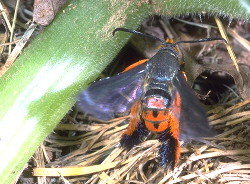





Zephyr is known in Greek mythology as the god of the West Winds. To me, Zephyr means the best squash I have ever grown OR tasted.
Adding to those accolades is the fact that Zephyr is probably also the most beautiful squash you'll ever see. Two-thirds of the club-shaped fruit is bright yellow, while the blossom end has a distinct green section. Closer inspection will reveal faint white lines running the length of the fruit. Many farmer's market growers are beginning to offer this squash just because its appearance attracts so much attention.
To date, Johnny Seeds is the only place in the U.S. from which you can purchase Zephyr squash seeds for home growing. The famous seedsman developed the hybrid in 1999 from a cross between yellow crookneck squash and another hybrid squash that was created from a cross between delicata and yellow acorn squash.
All of these good "genes" result in Zephyr boasting a delicate, nutty taste. This is a squash that is yummy both raw or cooked, as long as the fruits are harvested young (4-6" is about the max). As with all squash and zucchini, the flavor starts to decline when the fruit begins to really get big.
Grow Zephyr just like you would any other squash variety: start seeds in full sun when the soil is warm. Add copious amounts of compost and water (squash are very needy of both) on a regular basis. Mulch the soil around each plant to keep the moisture levels even.
 Watch for squash vine borers during early summer. They arrive in the form of a beautiful, orange, fuzzy, moth-like creature (shown at left) that will proceed to lay eggs all over your cucurbits. The eggs hatch into nasty little caterpillars that make their way to the base of your squash plant, and then bore into the hollow stem. Once they are inside the plant, you will see wilting, declining fruit production and eventual death of the plant. Bad stuff.
Watch for squash vine borers during early summer. They arrive in the form of a beautiful, orange, fuzzy, moth-like creature (shown at left) that will proceed to lay eggs all over your cucurbits. The eggs hatch into nasty little caterpillars that make their way to the base of your squash plant, and then bore into the hollow stem. Once they are inside the plant, you will see wilting, declining fruit production and eventual death of the plant. Bad stuff.
The good news is that I've not had quite as much trouble with squash vine borers on Zephyr squash. I think it is a size issue; Zephyr does not get to be a gargantuan squash plant and the stems tend to be smaller in circumference. However, if borers are a frequent problem in your veggie garden, try putting foil underneath the plants when they're still small. This is said to disorient the moths from lighting on plants and laying eggs.
As I mentioned, Zephyr will not generally become one of those behemoth squash plants in your garden, but instead stays at around 18-24". You can expect mature fruits around 50-60 days from seed planting.
Once you've harvested a few of these beautiful squash, you'll of course be anxious to eat some. Here's a great Squash Casserole recipe to try:
INGREDIENTS:
Place the squash, onion, salt, and pepper in a large saucepan. Add a small amount of water. Cover and cook the squash until tender, stirring occasionally and adding more water if necessary. Drain the squash and onions; return to the pan and stir in the butter.
Butter a 1 1/2-quart baking dish well. Stir the crumbled crackers into the squash mixture, and turn into the buttered casserole. Pour the milk over the squash and sprinkle with the cheese and chopped pecans or crumbs. Bake at 350°, uncovered, for 20 minutes, until the milk is absorbed and the squash casserole is bubbly. Serve hot. Serves 4 to 6.
Resources:
Johnny Seed
Zephyr Squash PlantFiles entry
Images courtesy of Davepays (PlantFiles entry) and U. of Kentucky Entomology (Squash Vine Borer)
Copyright © www.100flowers.win Botanic Garden All Rights Reserved